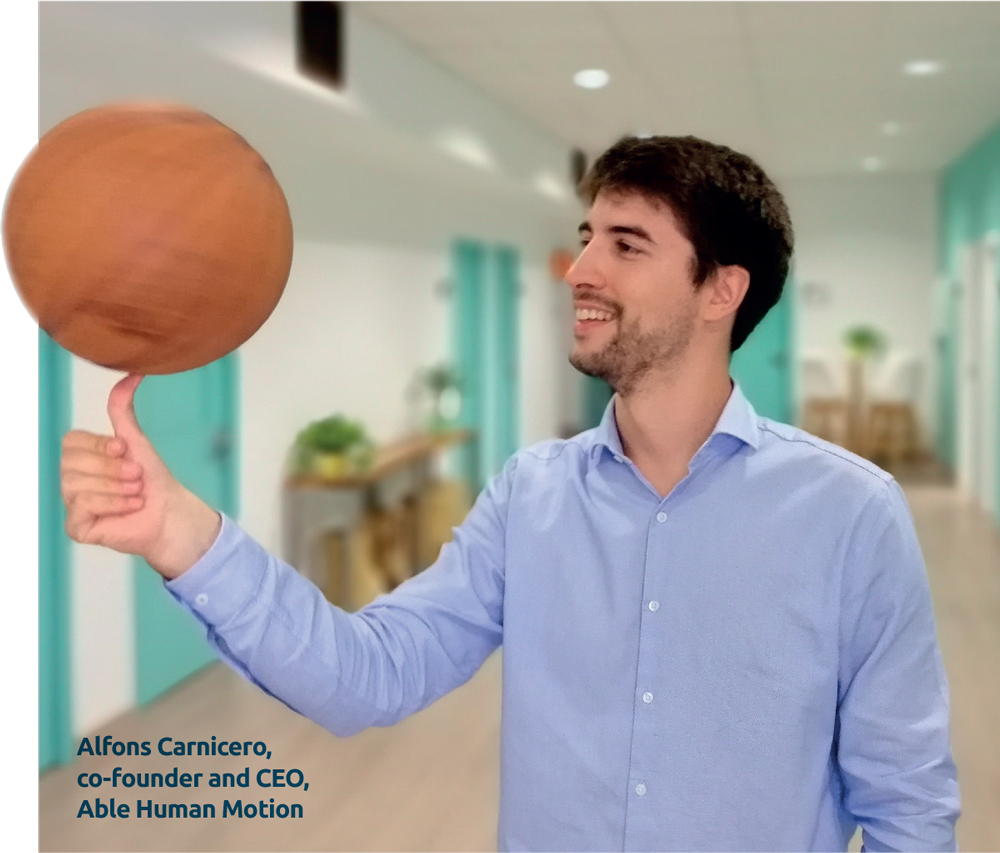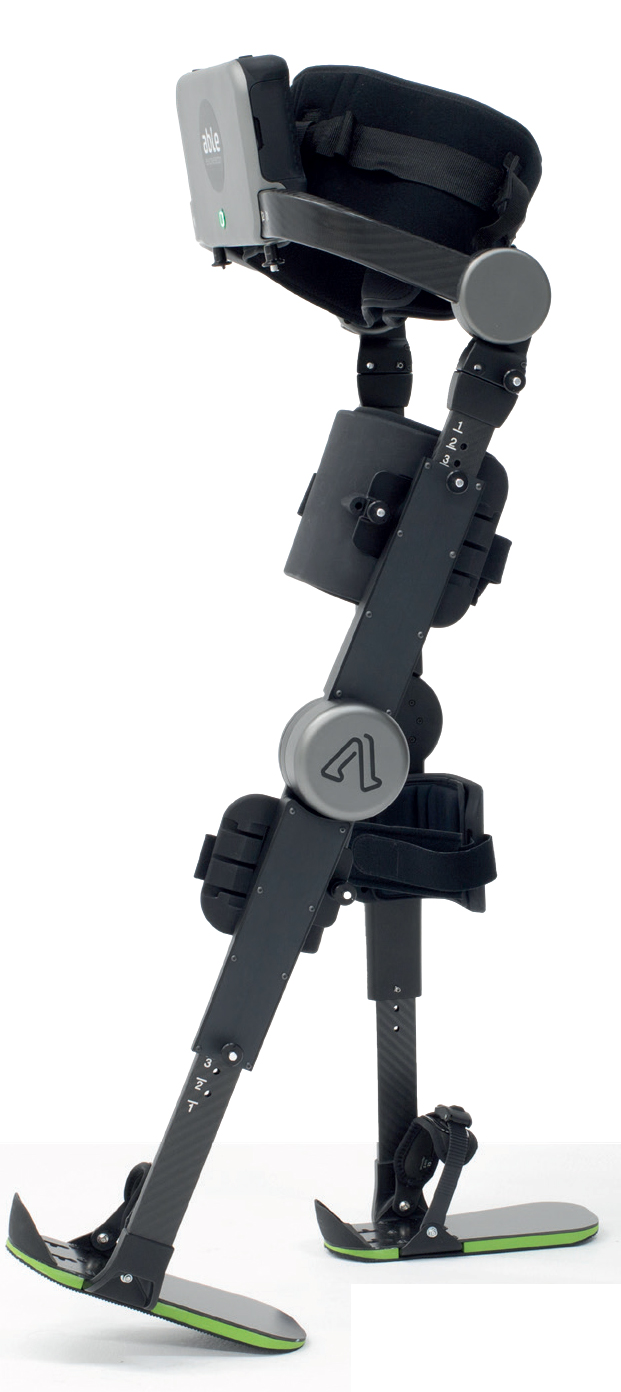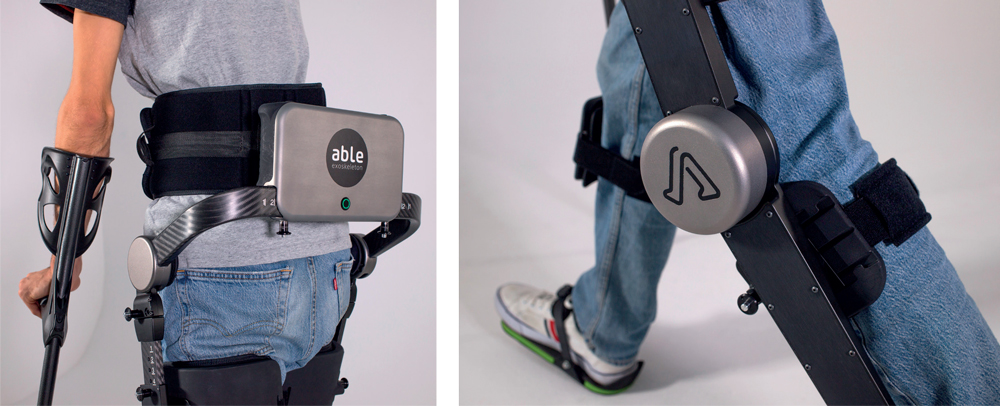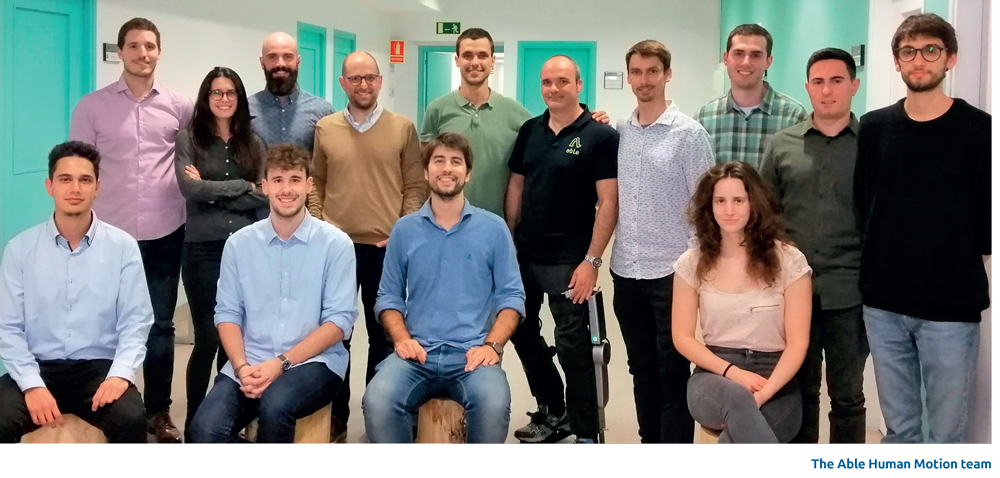Enabling human motion
Callan Emery speaks to Alfons Carnicero, co-founder and CEO, ABLE Human Motion about their groundbreaking rehabilitative exoskeleton and the challenges the startup has faced on their development pathway.
International Hospital: Your start-up company, Able Human Motion has developed ABLE – a powered orthosis,or exoskeleton, for spinal cord injured individuals. We’ll come back to this device, but first let’s look at the company. What was the seed idea that led to you starting up Able Human Motion and when did the idea originate?
Alfons Carnicero: I had been always fascinated by technology and sports, but when I was finishing my Bachelor’s, my father suffered a stroke, an event that changed my vital and professional interests: I decided to devote my career to create technology that improves people’s lives. Thus, after studying a Master in Biomedical Engineering and working in the MedTech industry, in 2017, I joined the University of Catalonia Biomechanical Engineering Lab led by Josep Maria Font, PhD to study the feasibility of taking a research project on robotic orthosis to the market. We spoke with more than 100 patients and clinical professionals, and realized that there was an unmet clinical need with a relevant market that our product could solve. We then contacted Alex Garcia, a colleague from the university that had expertise turning prototypes into products, and convinced him to join this exciting adventure in 2018 and create ABLE Human Motion: a company that aims to help many people with mobility impairments like my father through life-changing technology.
IH: Can you outline some of the initial processes / research that led to the establishment of the company?
AC: The initial idea arose in 2013 from a doctor from La Coruña (northern Spain), who observed that a group of patients did not have devices adapted to their needs, but only robotic exoskeletons that were inaccessible and not very versatile for daily use. This triggered an investigation between the Universities of Catalonia (UPC), Coruña (UDC) and Extremadura (UEX) that led to the first prototypes. From Barcelona, the research was led by Josep Maria Font, PhD, professor of the UPC and Director of the Biomechanical Engineering Lab.
During the first years, in order to understand how to properly assist gait in spinal-cord-injured individuals, the research was mainly focused on the development of multibody biomechanical models to analyse and simulate human gait dynamics. Later, the first laboratory prototypes were created prior to the establishment of the company.
IH: When and where did you establish the company?
AC: In Barcelona (Spain), in October 2018. Barcelona is one of the most dynamic startup hubs in Europe these days, with a lot of talent and a strong Medtech and Biotech startup ecosystem.
IH: Seed funding is a key issue for startup initiatives. Can you explain how you raised seed funding and what the funding was used for?
AC: In the beginning, there is only one way: pitching the project to as many people as possible, and then improve your speech based on the feedback received. At that time, participation in acceleration programmes such as Caixaimpulse or CRAASH Barcelona (Biocat, CIMIT), where you receive mentoring from experts in the health sector, is key. So after being rejected multiple times and having refined our pitch, in Q2 2019, we managed to raise a seed round of €700,000 with Business Angel investors, small investment vehicles, Family Offices and Friends & Family, that we used to turn the lab prototype into an industrial product. We developed five iterative prototypes learning from the feedback of clinicians and testing with 15 paraplegic individuals to adapt, change and redesign the device with iterative cycles.
Then, last year we completed seed funding with a €500,000 investment of EIT Health (European Institute of Innovation & Technology) to clinically validate the exoskeleton for paraplegia in leading clinical institutions like Institut Guttmann and Heidelberg University Hospital and obtain the CE certification.
By the way, another thing that we have not stopped doing since the very beginning is writing project proposals to achieve public funding, and it takes time but it works!
IH: How have managed the growth of the company?
AC: By understanding very well the needs of the company at each phase and maximizing the resources available. And here the help of advisors that have been serial entrepreneurs such as Bart Huisken, PhD or John Collins, PhD has been critical.
In the initial stage, all our efforts were put into R&D to quickly develop prototypes and test them with patients. Later, we incorporated experience in clinical affairs to prepare the protocols of the clinical studies to validate our technology in a hospital environment with larger patient populations. The next step has been to add regulatory and quality expertise to the team, in order to prepare all documentation for regulatory authorities towards certification and implement a rigorous quality management system in the company. So, in just two years, we have gone from being only the three founders to employing 12 full-time people (and growing). But what is great is that the atmosphere and the company culture stays the same as the first day, and we maintain the same core values: curiosity, humbleness and fearlessness.
IH: What were some of the main challenges you faced along the way and how did you resolve these?
AC: We have found many challenges and difficulties along the way, the important thing is to learn from mistakes and persist. For example, I cannot remember how many times investors rejected us when we initially pitched the project. But we improved the message and looked for more specialized investors who understood the peculiarities of the medical sector, especially its longer time-to-market and commercialization strategies. Once the first investors were convinced, closing the round was much easier. In fact, we exceeded our expectations and we decided to increase the size of the seed investment round. Another challenge has been to involve the right people and partners. Being young, it was very important for us to select a group of expert advisors with an extensive network of contacts and the ability to support us in solving the problems that arise. In order to move forward, it has been key to engage the best-inclass partners, with leading hospitals such as Institut Guttmann, Heidelberg University Hospital or ASEPEYO, technological partners like Ingenia Motion Control or Harmonic Drive and research institutions like the UPC Biomedical Engineering Research Centre.
A huge challenge we face and will face in the coming years is the lack of innovation in the area of rehabilitation. Thus, options available to patients for standing and gait training are sub-optimal and have not changed much in the last 50 years. Therefore, it is a challenge to introduce an innovative device like ours in to clinical practice, when, for example, therapists are used to doing mobilizations manually. Disincentives such as fragmented markets, regulatory requirements, and reimbursement difficulties are not helping this change.
Finally, a challenge that we overcome every day is that, although there are criteria to classify injuries, each person is different. For this reason, we are trying to adapt our technology to the needs and evolution of each user, both ergonomically and functionally.
But this is just the beginning, and we have many challenges ahead for when we start the commercialization. First, is the lack of brand awareness, as key industry players in the market are well-established companies, so it is difficult for incoming small enterprises to generate trust and traction with key clinical opinion leaders. And second, there are very few existent reimbursement policies for exoskeletons: the cost of medical exoskeletons is currently not reimbursed (or co-paid) by public health systems. Economic and clinical studies, providing a systematic evaluation of their effects over the long-term, need to be performed to boost reimbursement on a wider basis and comprehensive decision-making by regulatory institutions and healthcare professionals.
IH: Can you give us some detail about the ABLE device?
AC: Yes, it is a powered exoskeleton: an external supporting structure placed on the user’s body to reinforce or restore human motor function with powered movement. The device is attached through straps to the lower-body and has a motor in each knee joint that acts as an artificial muscle, flexing and extending the leg to actively help the user to stand up, walk and sit down, mimicking natural movement. It embeds smart sensors and algorithms that seamlessly detect the user’s intention to take a step, without performing unnatural postural cues.
This patented system incorporates the most advanced robotics techniques, together with Machine Learning algorithms to personalize the gait patterns.
The structure of the exoskeleton is made from aluminium, 3D printed plastic and carbon fibre because it needs to withstand significant loads while being light and slim. It is accompanied by a cloud-based mobile app that enables a personalized therapy with real-time adjustments and quantifiable metrics to track the patient’s progress.
The ABLE Exoskeleton is intended for paraplegic individuals with a spinal cord injury, both complete and incomplete, to perform ambulatory functions in rehabilitation institutions under the supervision of a trained physical therapist.
The device can be used both as an assistive gait training tool, helping with weight shifts, improving step patterns and cadence, and as a rehabilitation, delivering more intensive and repetitive exercises, that together with early mobility lead to a faster recovery. It is not meant to be used permanently during the entire day, only for 2-3 hours a day. The technology aims to provide clinicians with a tool to increase the efficiency of rehabilitation, and patients with a solution that boosts daily ambulation and improves their rehabilitation outcomes, while empowering them in the community and contributing to improving their mental health.
IH: What sets it apart from similar competitive devices?
AC: Similar competitive devices focus on targeting all lower-limb mobility impairments with a single device (one-size-fits-all approach). This results in very expensive (from €60k to €150k), heavy (from 14 to 25kg), and complex devices that can only be afforded by large clinical institutions. At ABLE, we are trying to disrupt the exoskeleton market from the bottom up, focusing on the design of exoskeletons for specific pathologies, resulting in user-centred solutions with the following advantages: lightness, adaptation to their motor capabilities, continuum of care from the hospital to home, and cost-effectiveness.
This approach, together with years of research at UPC and key partnerships, has led to the ABLE Exoskeleton: the first lightweight, intuitive and affordable robotic exoskeleton that allows paraplegic individuals to stand up and walk autonomously. The compact and lightweight design of our exoskeleton (9.5kg), along with the significant reduction in cost (80% compared to main competitors), will drive a much faster penetration in the domestic market (daily use at home by end-users).
These are the five unique points that make the ABLE Exoskeleton stand out from its main competitors:
- Lightness and compactness: A delicate and optimized mechanical structure using carbon fibre, aluminium and 3D-printed parts, together with the most compact high-power actuator and electronics. It weighs less than 10kg, which will make it the lightest medical exoskeleton in the market.
- Seamless walking: The intention to initiate each step is detected seamlessly using motion sensors, interpreting the minimal movement preserved by the user, with no need of performing unnatural postural cues. The algorithm is personalized to each user to meet their specific requirements during gait.
- Modularity: The system is composed by five modular components that allow quick donning and doffing, while offering ease of handling, transportation, and storage in a cabin size baggage. Therapists can adjust the exoskeleton sizes without using any tool, to properly fit a user. This single-handed and rapid adjustability using pinlocks improves the efficiency of the rehabilitation sessions.
- Adapting rehabilitation to each user. Therapists can help users with a beginner level by operating the exoskeleton and initiating steps manually (with push-buttons). Advanced users can operate the exoskeleton fully autonomously by using a wireless remote controller attached to the crutch or walker.
- ABLE Care software: It enables the adjustment of gait parameters in real-time such as swing flexion and swing phase time, while monitoring gait metrics (walking time, distance, speed, step length, gait symmetry). It also records walking sessions and patient’s data so therapists can track the patient’s progress and adapt rehabilitation sessions to their needs.
IH: The device is not yet CE-approved. At what stage are you in the approval process and when do you expect to commercialise the exoskeleton?
AC: Yes, our device is not yet CE-approved. We are currently performing a multicentre clinical study in two leading neurorehabilitation hospitals – Heidelberg University Hospital (Germany) and Institut Guttmann (Spain) – to evaluate the safety, feasibility and usability with 30 spinal cord injured patients. With this clinical data, we will be able to complete our technical file submission for the European authorities, to obtain the CE certification and start commercialization in Europe in the first half of 2022. We will then aim to enter the United States market at the end of 2023 after obtaining the FDA clearance.
IH: Do you have other products in the pipeline?
AC: Yes, we are developing a disruptive and ultra-light exoskeleton for hemiplegic gait after stroke: a powered ankle joint that assists only on the affected side of the body with adaptive algorithms that collaborate with the remaining muscular function and promote the process of neuroplasticity during rehabilitation. With stroke being the leading cause of movement disability in the US and Europe, this device is expected to become a game-changer, situated in a unique position to set a new standard for the poststroke rehabilitation. This device is expected to enter the European market in early 2024, after obtaining the CE-mark approval.
With the world population ageing and thanks to the knowledge acquired in those projects, we aim to launch a new generation of exoskeletons by 2026 to improve mobility of the ageing population, preventing fall-related injuries and allowing them to be active longer.
IH: How can parties who are interested to invest in your company go about doing this?
AC: By sending an email to hello@ablehumanmotion.com with the subject: “Interested investor”. They can also reach out to us through our social media channels on Twitter (@AbleHumanMotion) or LinkedIn (www.linkedin.com/company/ablehumanmotion/).
IH: Lastly, what are some of the key things you have learnt in this process that you can pass on to others who are about to begin this journey?
AC: There are many things we have learned in these few years. I will emphasize six of them:
- Everything seems easier than expected. Entrepreneurs tend to be very optimistic, so better add 50% to your expected timings and expenses. This applies also to investment rounds, you will need more money than you think and it will take longer to achieve it.
- The entrepreneurial journey is a rollercoaster. This is why I recommend to always have a co-founder, so you do not feel alone and can share failure and success. No matter how many failures you have, persist and you will succeed!
- Ask for help and surround yourself with people you can learn from. There are a lot of people and initiatives willing to help, but you have to choose well.
- Work with a lean methodology with all stakeholders, gather feedback from the market as soon as possible to design a device that responds to what users really need. In the early stage, we lost time and resources because we only tried the new developments with one pilot.
- Entrepreneurship is a hard and very intense process, it’s not meant for everyone. This idea of a “cool” entrepreneur lifestyle does not exist, at least here. It takes a lot of effort and you have to give up on many things, but it is also very rewarding seeing your “baby” growing. Every month I tell myself: “next month I will have more time”, but this is never the case!
- Recruit an outstanding team. This is one of the most important and difficult tasks as a founder, and one of the things I am most proud of!





